Why Your Toilet Water Rises Then Slowly Drains
Author: Omar Alonso | Editor: Omar Alonso
Review & Research: Jen Worst & Chris Miller

Have you flushed the toilet only the find the water slowly draining away? Why didn't it do the usual "whoosh" and suck everything up the pipes? What's wrong? Is the toilet going to overflow and leave your bathroom and home in a mess? We'll explain why the toilet water rises then slowly drains away.
Why Does My Toilet Fill Up Then Slowly Drain?
There could be several reasons the toilet water rises and slowly drains away. Let's look at the common problems causing the issue.
Toilet Clogs
A clog in the pipes is the primary reason the water rises in the toilet bowl and drains away slowly. There are two types of clogs, severe and minor. If the water drains away, you likely have a minor clog. If the water doesn't drain away, it's a severe clog.
Minor clogs are easy to take care of, and in most instances, they aren't anything to worry about. a severe clog is a different problem requiring immediate attention.
A Drop in the Water Level in the Tank
If there's not enough water in the tank (cistern), there is not enough water to flush away the waste. This is the most important factor to make a toilet flush better. As a result, it might cause a minor clog in the pipework. Don't place anything in the tank to use less water. We get you're trying to be water-wise, but your noble intentions could clog the lines.
Clogs in the Ports & Rim Jets
If when flushing the toilet water rises then slowly drains, you might have a toilet design with rim jets and ports that release water into the toilet bowl. If they clog, it affects the water flowing into the toilet bowl, giving it a weak flushing pressure. As a result, the waste ends up blocking the lines.
What to Do When the Toilet Water Rises Then Slowly Drains
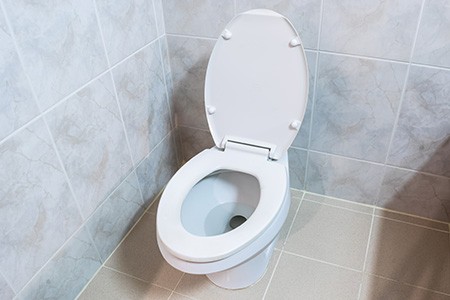
If the toilet water rises and slowly drains away, you're going to have to take action to resolve the problem – or maybe you don't. Minor clogs usually aren't a problem. They break up by themselves in a few hours, and you can flush them away when the water level drops.
However, this strategy means you'll have to wait a few hours for the clog to break. If someone else needs to use the toilet, you'll have to break the clog up, or another flush could result in the water flowing over the toilet bowl onto the floor.
Unclog Your Toilet in 3 Ways
If your toilet fills up then slowly drains, you undoubtedly have a clog. Here are three methods for unclogging your toilet that you can take advantage of using items already in your home, most likely. No more waiting for a toilet to unclog itself. Get it done now so you can use the toilet when needed.
Try a Plunger
The first method is to use the standard type of toilet plunger for the task. Inset it into the toilet bowl and cover the mouth of the bowl leading to the pipework. Work the plunger back and forth. You should feel it suck to the mouth and create pressure. You'll feel that pressure release when the clog breaks up. Remove the plunger and flush the toilet; it should run as normal.
Use a Plumbing Snake
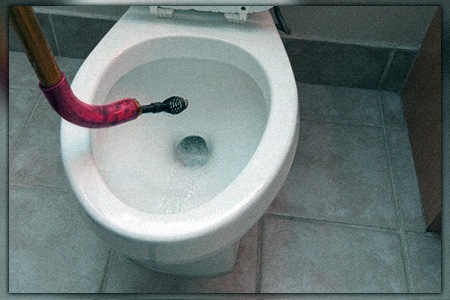
The "toilet snake" is a professional plumbing tool known as a "toilet auger" in the industry. It's a long steel line that flexes in different directions. The plumber inserts it into the toilet bowl and works it into the bowl mouth and pipework, breaking up the clog.
After it's free, flush as normal. You can make a DIY plumbing snake using an old wore coat hanger. Undo the hanger around the neck and fold it together. Insert it into the toilet bowl and work the hook into the mouth.
Push it back until you find the clog, and break it up by moving the hanger back and forth. If you can't feel the clog, it's deeper in the line. You'll have to call the plumber if you're dealing with a severe clog. But if your toilet fills up with water then slowly drains, try some of these other fixes before calling for help.
Use Salt & Hot Water
If you don't have a plunger or plumbing snake, or don't feel comfortable using them for whatever reason, you can try salt and hot water. Make sure you never use boiling water as it can create such a quick change in temperature that you can crack the bowl and pipes of the toilet.
Unclogging a drain with salt is possible because it helps dissolve (with the aid of vinegar or baking soda if you have it) clogs, acts as an abrasive to scrape away and loosen clogs, and will help dehydrate the clog to make it smaller.
Add Baking Soda & Vinegar
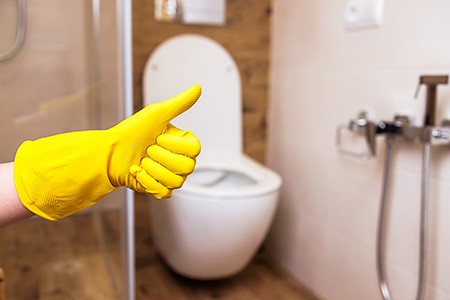
Baking soda and vinegar are useful household cleaning combinations for several takes around the home. From cleaning the stovetop to removing stains off the floor or carpet, vinegar and baking soda have powerful cleaning actions.
Mix a cup of vinegar with four cups of warm water and add 1 cup of baking soda. Mix it up and steadily pour it into the toilet bowl. If you're dealing with a hair clog, then add some salt to the mix, and remember to never flush hair down the toilet.
The effervescence of the baking soda and the acidity of the vinegar break up the clog. Ensure you don't add bleach to the vinegar. Bleach and vinegar combine to create poisonous chlorine gas. Give the vinegar and baking soda solution five to ten minutes to work, and flush the toilet. If you want to use bleach, you can mix bleach and baking soda safely if you leave the vinegar out.
Pour Dish Soap Into the Bowl
Common household dish soap is great for cleaning dishes, and it's also great for loosening toilet clogs. The soap surrounds the clog, releasing it from the walls of the piping. Allowing it to flush away easily. When your toilet water rises then slowly drains, reach for the dish soap as a first, easy fix attempt.
Add a quarter cup of dish soap to 4 cups of hot water and pour it into the toilet bowl. The water level rises and drops, meaning the dish soap is now around the clog. Give it five or ten minutes to work the magic and flush the clog away.
It's important to note that you should never use boiling water for the task. Adding boiling water to the toilet bowl may cause thermal shock to the porcelain material, resulting in the cracking of the toilet and the need for a costly replacement.
When your toilet bowl fills too high and drains slowly it can set panic into you before you realize it's not going to overflow. Don't rush off for boiling water, not only due to the cracking of your toilet as we mentioned, but for another very important reason.
This tip is especially important when working with bleach. Adding bleach to hot or boiling water produces lethal chlorine gas that could seriously harm you, especially in a small, poorly ventilated space like the bathroom. Never add bleach to hot water or to acid or ammonia-based cleaners.
Tips to Ensure Effective Flushing of Your Toilet
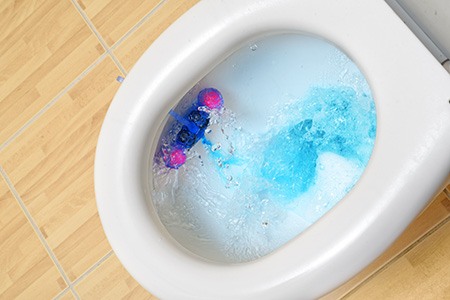
Ineffective flushing of the toilet is a common cause of clogs. It's important to ensure your toilet is in working order. Like all other appliances in your home, the toilet requires maintenance to ensure effective operation. Follow these tips to keep your toilet in tip-top working order.
Increase the Tank Water Level
If you have anything in the toilet tank, remove it. It prevents the adequate buildup of water, resulting in weak flushing. Next, pour additional water into the tank, and let it cover the float attached to the toilet flapper. Wait until the dish soap acts on the clog, and flush the toilet.
The additional water will provide a strong flushing action, or if you're unlucky, it backs up and floods the floor. You can add more water to each flush by bending the flapper arm attached to the ball float. This causes the float to require more water to enter the tank to seal it off.
Clean the Ports & Rim Jets
The ports and jets around the toilet bowl send water into the bowl, creating a vortex when you flush. If the jets and ports are blocked, it affects the normal flushing operation of the toilet. As a result, there's a high potential for clogs to form.
If you can see the ports and jets, you can use the metal hanger trick and work the top of the hanger into the ports to remove any mineral buildup that might be causing the problem. Grab a toilet brush and scrub the toilet ports using dish soap; it should be sufficient to clean the ports and break up any clots causing ineffective flushing.
Other Issues Causing Clogs in the Toilet & Pipework
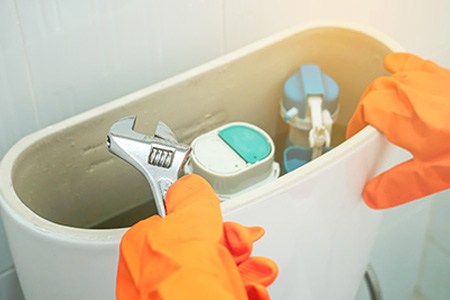
If your toilet almost overflows then drains slowly, there might be other issues affecting its operation other than what we have discussed. Here are a few other less-common problems causing the situation.
Weak Flushes
A weak flush reveals other issues with the toilet. Clogs commonly cause inadequate flushing and rising water in the toilet bowl that drains away slowly. A soft flush might only move some of the waste down the pipework, resulting in a clog developing.
Damaged Flapper
The toilet flapper is the device sitting in the tank that controls the effective flushing of the toilet. No types of toilet flappers are designed to have a permanent installation or last forever. According to manufacturers, the flapper has around a five-year service life.
If it malfunctions, it can result in water running out of the tank and a weak flush. We've published guidance on fixing a running toilet without a ball float if that's the scenario you find yourself in.
Leaking
If the toilet has water around the base, you could have a problem with a leak in the tank, the pipes, or the components leading the water to the bowl such as your toilet flange types. You'll have to call a plumber for assistance if the toilet leaks or at minimal replace the flange.
Phantom Flushes
Phantom flushes occur when the toilet decides to randomly flush by itself. The most common cause of phantom flushing is a broken or faulty toilet flapper. The flapper is the device sitting inside the tank that controls the flushing process.
That's Why Your Toilet Water Rises Then Slowly Drains
If the toilet water rises and slowly drains, you have a clogged toilet. You can let this work itself out, or you can take action to resolve the situation. If you don't have time to wait, follow the advice in this post and get rid of the clog right away.
If you experience frequent clogging of your toilet, it could be a sign of a bigger problem with the toilet. If that's the case, you can follow the cleaning tips in this post or call the plumber to come and sort it out for you. Now we know why your toilet water rises then slowly drains.



